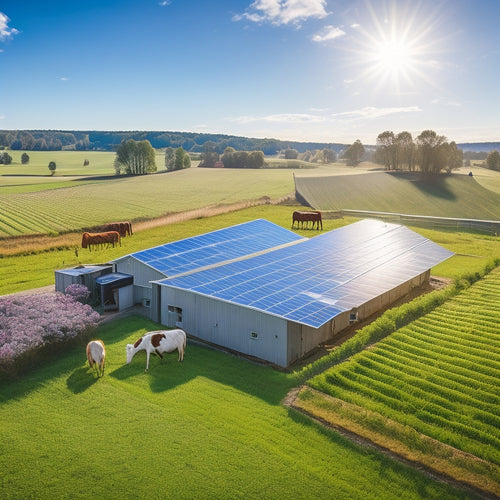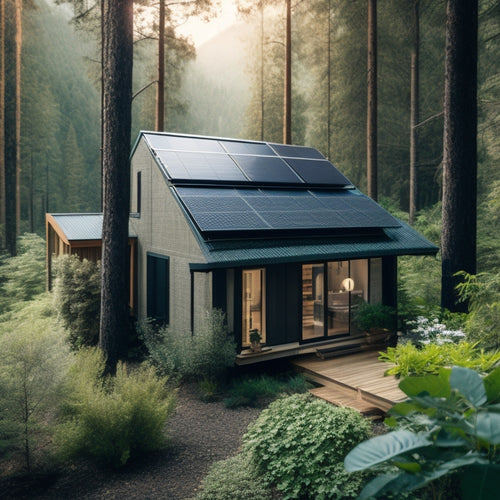
Solar System for Your House
Share
You're considering a solar system for your house, which means you're taking the first step towards achieving energy independence, reducing your carbon footprint, and increasing your property value. By installing solar panels, you can eliminate energy bills, gain control over energy production, and even sell excess energy back to the grid. Additionally, solar systems can enhance your property value by up to 15%, making your home more attractive to potential buyers. As you investigate the world of solar energy, you'll uncover how micro-inverters optimize energy harvesting, and how evaluating your roof's shading impacts system efficiency. Now, uncover the specifics that will take your solar expedition to the next level.
The Essentials
- Achieving energy independence through solar systems reduces reliance on the grid and contributes to increased savings for homeowners.
- Solar installations enhance property appeal, increasing resale value by up to 15% and providing a substantial return on investment.
- Aesthetic design of solar systems can complement home architecture, with careful panel placement and color coordination to enhance overall design coherence.
- Roof suitability and shading analysis are crucial for optimal solar panel placement, as obstructions and shading patterns impact energy production and system efficiency.
- Advances in energy storage technology enable excess energy use during peak demand times, allowing homeowners to gain control over energy production and usage.
Zero Energy Bills Possible
With a well-designed solar system, you'll achieve energy independence, relying on the sun's power to fuel your daily needs. This means you'll greatly reduce your reliance on the grid, and in many cases, eliminate your energy bills altogether.
By integrating a home battery storage system renewable energy solutions, you'll be able to store excess energy generated by your solar panels and use it when needed, further reducing your reliance on the grid. Additionally, this setup will also enable you to shave peak demand charges and reduce your overall energy usage during those times of the day when energy rates are at their highest.
Energy Independence Achieved
By integrating solar panels into your home's energy system, you're taking a significant step towards slashing your reliance on the grid and potentially eliminating your energy bills altogether. This means you'll no longer be at the mercy of utility companies, with their ever-fluctuating rates and unpredictable price hikes.
With a solar system, you'll be generating your own clean energy, and storing excess energy in batteries for later use. This energy independence is made possible by advances in energy storage technology, which has become more efficient and affordable in recent years.
Here's a breakdown of the benefits:
| Benefit | Description | Result |
|---|---|---|
| Reduced Energy Bills | Lower or eliminate energy bills | Increased Savings |
| Energy Independence | Generate and store your own energy | Reduced Reliance on Grid |
| Solar Incentives | Take advantage of government incentives | Increased ROI |
Reduced Carbon Footprint
Your carbon footprint shrinks considerably when you switch to a solar-powered home, and the best part is that you can potentially eliminate your energy bills altogether.
By utilizing renewable energy from the sun, you'll reduce your reliance on fossil fuels, which are significant contributors to greenhouse gas emissions. As a result, you'll be doing your part to mitigate climate change and promote sustainable living.
With an all-encompassing solar power system for your house, you can also eliminate the worry of rising electricity bills, solving the problem of sky-high energy costs that strain your budget every month.
To put this into context, consider that the average American home produces around 7.5 tons of carbon dioxide equivalent (CO2e) per year. By going solar, you can offset a substantial portion of these emissions, making a significant dent in your carbon footprint.
This reduction in emissions can be further augmented by incorporating carbon offset strategies, such as energy-efficient appliances and smart home devices, into your daily routine.
Increased Property Value
When you install a solar system on your house, you're not only reducing your energy bills, but also increasing your property's appeal to potential buyers.
With affordable solar panels available in the market, such as residential solar panels, homeowners can now enjoy the benefits of renewable energy without breaking the bank.
A solar panel installation can enhance your home's curb appeal, making it stand out from neighboring properties.
As a result, you can expect a better resale price, which can greatly offset the initial investment in your solar system.
Enhanced Curb Appeal
A well-designed solar panel system can greatly enhance your home's curb appeal, making it more attractive to potential buyers and increasing its resale value. You want a system that complements your home's aesthetic design, integrating seamlessly with your landscaping and color scheme. This harmony is essential to maintaining design coherence and adhering to neighborhood trends.
| Design Element | Consideration |
|---|---|
| Panel Placement | Optimize placement to minimize visual impact, considering roof types and local regulations |
| Color Coordination | Match panel frames to your home's trim, gutters, or roofing to create a cohesive look |
| Landscaping Integration | Incorporate greenery or flowering plants around the system to enhance visual appeal |
| Outdoor Lighting | Strategically position lights to highlight the system's sleek design and create ambiance |
Better Resale Price
Installing a solar panel system can greatly enhance your property's resale value, providing a substantial return on investment. This is because market trends are increasingly shifting towards energy-efficient and eco-friendly homes, which are highly sought after by modern buyers.
As a homeowner, you'll be ahead of the curve by investing in solar energy, making your property more attractive to potential buyers.
According to recent studies, homes with solar panel systems sell for up to 15% more than similar homes without them. This significant increase in value is largely driven by buyer preferences for sustainable living and reduced energy costs.
By installing a solar system, you'll not only reduce your carbon footprint but also appeal to the growing demographic of environmentally conscious buyers.
When it comes time to sell, your solar-powered home will stand out in a competitive market, giving you a distinct advantage over comparable properties.
Micro-inverters Boost Energy Output
You'll get the most out of your solar system with micro-inverters, which facilitate max power harvesting from each individual panel.
High-efficiency solar panels, designed with photovoltaic cells and optimized energy flow, guarantee that shaded or underperforming panels don't drag down the entire system's output.
Max Power Harvesting
As the solar panels on your roof absorb sunlight, their photovoltaic cells convert it into direct current (DC) electricity, but this power isn't immediately usable in your home.
That's where micro-inverters come in – they convert the DC power into alternating current (AC) electricity, which is what your home uses.
But micro-inverters do more than just convert power; they also enable maximum power harvesting.
Optimized Energy Flow
Micro-inverters' ability to enable maximum power harvesting is closely tied to their capacity for optimized energy flow. This means you can expect a significant enhancement in energy output from your solar system.
By installing micro-inverters, you'll be able to monitor and control each panel's performance individually, ensuring that every unit operates at its maximum potential. This level of energy management allows you to identify and address any issues promptly, minimizing energy losses and maximizing your system's overall efficiency.
When it comes to system integration, micro-inverters play an essential role in ensuring seamless energy flow. They enable your solar system to adapt to changing environmental conditions, such as shading or debris, and optimize energy production accordingly.
This results in a more stable and efficient energy supply, giving you greater control over your energy usage and costs. By optimizing energy flow, micro-inverters help you make the most of your solar system, providing you with the freedom to generate and manage your own clean energy.
Assess Your Roof's Shading
When evaluating your roof's shading, you'll need to analyze obstructions such as skylights, vents, and chimneys that can cast shadows on your solar panels.
You'll also want to identify the shading patterns created by surrounding objects, like trees or neighboring buildings, which can impact your system's performance.
Additionally, it's crucial to contemplate the benefits of Renewable energy systems and how they can contribute to energy independence.
Roof Obstructions Analysis
Your roof's layout and obstructions play a crucial role in determining the suitability of your house for a solar power system.
When evaluating your roof's shading, it's important to take into account the orientation of your roof, as it affects the amount of sunlight your solar panels will receive. A south-facing roof with little to no obstructions is ideal, but if your roof faces east or west, you may still be able to install a solar power system.
Obstructions such as chimneys, skylights, and vents can create installation challenges and reduce the energy output of your solar panels.
You'll need to factor in the size and location of these obstructions to determine the best placement for your solar panels. Additionally, you'll want to evaluate the roof's pitch and material, as these factors can also impact the installation process.
Shading Pattern Identification
Beyond roof obstructions, shading patterns also greatly impact your solar power system's performance.
As you assess your roof's shading, you'll need to identify the shading patterns that affect your solar panels' energy production. A shading analysis will help you determine the extent of shading on your roof, taking into account factors like nearby trees, buildings, and even the roof's own features, such as vents and skylights.
You'll want to evaluate your roof's solar orientation, too, as this affects the amount of sunlight your panels receive. South-facing roofs typically receive the most sunlight, while east- and west-facing roofs get less.
Shading patterns can vary considerably depending on the time of day and season, so it's crucial to reflect on these factors when selecting the best placement for your solar panels.
Higher Efficiency in Snow
You'll want to contemplate a solar panel system designed to optimize energy production in snowy climates, as traditional systems can experience significant efficiency losses due to snow accumulation.
In fact, snow can reduce solar panel efficiency by up to 50% if not properly addressed. By selecting a system with snow-specific features, such as tilted panels and snow-repelling coatings, you can minimize energy losses and maintain a higher level of performance even in the snowiest of winters.
Snowy Climate Performance
Installing a solar panel system in a snowy climate may seem counterintuitive, but modern technology has made it a viable option. You'll be pleased to know that solar panels can still generate significant amounts of energy even on cloudy winter days.
However, it's crucial to take into account the snow accumulation impact on your system's performance. Snow can block sunlight, reducing energy production, but it's not a significant concern if you follow proper winter maintenance tips.
To minimize snow's impact, make certain your solar panels are installed at an angle that allows snow to slide off easily. You can also invest in a snow-raking system or hire a professional to clear the snow from your panels regularly.
Additionally, think about investing in a monitoring system that tracks your energy production and alerts you to any performance issues.
Frequently Asked Questions
Can I Install Solar Panels on My Old or Historic Home?
You can install solar panels on your old or historic home, but you'll need to take into account historic home considerations, ensuring solar panel aesthetics blend with your home's original character, and complying with local preservation regulations that may impact your installation.
Do I Need to Clean My Solar Panels Regularly?
You'll want to prioritize panel maintenance, as dirt accumulation can reduce energy output by up to 25%. Regular cleaning guarantees peak performance; schedule bi-monthly inspections and cleanings to keep your system running efficiently, maximizing your energy independence.
Can I Use Solar Power for My Electric Vehicle?
You can utilize solar power to charge your electric vehicle through solar charging, reducing reliance on fossil fuels and promoting energy independence; however, you'll need a compatible charging station and sufficient solar panel capacity.
Will Solar Panels Affect My Roof's Warranty?
You've seen how Tesla's solar panels seamlessly integrated into a California homeowner's roof, but you're wondering: will solar panels affect your roof's warranty? Typically, solar panel installation won't void your roof warranty, but it's crucial to review the terms and manufacturers' agreements to make sure you're covered.
Can I Add More Panels to My Existing System Later?
You can expand your existing system later, but guarantee compatibility by checking your inverter's capacity and panel specifications, allowing you to add more panels seamlessly, giving you the freedom to scale your system expansion as needed.
Final Thoughts
You've got the power to utilize the sun's energy and change your home into a sustainable haven. With a solar system, you can bid farewell to zero energy bills and hello to a significant increase in property value. By evaluating your roof's shading and utilizing micro-inverters, you'll maximize energy output. And, surprisingly, snow can even enhance your system's efficiency. So, what's holding you back from illuminating your home with clean, renewable energy?
Related Posts
-

What Do I Need to Know About Farm Solar Panels
When considering farm solar panels, you need to assess costs, benefits, and technical specifics. Initial investment c...
-

Solar Phone Chargers for Camping Essentials
Solar phone chargers are must-haves for your camping essentials, allowing you to stay connected while enjoying nature...
-

Off Grid Solar Batteries
As you shift to off-grid living, you'll rely on high-performance solar batteries to store excess energy generated by ...


